Pilgrimages
FAR AWAY, CORFU STILL REMEMBERS EVENTS FROM A CENTURY AGO
The Epic of Heroism and Suffering
Every generation in Serbia must read this, experience in itself and go there to pay respect. And keep the memory as Christo Yanulis from Agios Matheos does it, whose grandfather shared bread and wine with Serbian martyrs and gave a part of his estate for the cemetery of the Drina Division. Corfu is filled with Serbian traces and monuments. All those heartbreaking stories and songs are still alive. There, in Corfu, we may also measure to what extent we, of this day, are still alive
Text and photo: Mišo Vujović
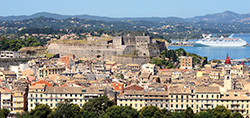 While swaying gently in the breeze, cutting the crystal transparence of the Ionian Sea, where the image of a thousand-year old fortress from the era of mighty Byzantine Empire is reflected, an old boat filled with pilgrims was approaching the little island. Beats of the anthem of suffering ”There, Far Away” sadness and pride evoked the drama of a people decided not to capitulate and not lose its state at any cost. The only salvation, in the opinion of Duke Radomir Putnik, was withdrawal to the Adriatic Coast, to enable the Serbian army to reorganize itself, get supplies of weapons, food and ammunition and again become a serious player that the allies must count on.
While swaying gently in the breeze, cutting the crystal transparence of the Ionian Sea, where the image of a thousand-year old fortress from the era of mighty Byzantine Empire is reflected, an old boat filled with pilgrims was approaching the little island. Beats of the anthem of suffering ”There, Far Away” sadness and pride evoked the drama of a people decided not to capitulate and not lose its state at any cost. The only salvation, in the opinion of Duke Radomir Putnik, was withdrawal to the Adriatic Coast, to enable the Serbian army to reorganize itself, get supplies of weapons, food and ammunition and again become a serious player that the allies must count on.
After the initial Serbian successes on the Cer and Koluba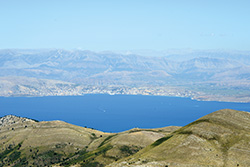 ra, a brilliant counteroffensive in Bosnia in 1914, a brief war break until autumn 1915, the Central Powers started the general offensive against the Kingdom of Serbia, already exhausted in the Balkan Wars and the said battles from the previous year. Although a hundred times more powerful in terms of the number of troops, technical equipment and weapons, German Emperor Wilhelm, the proven enemy of the Serbs (”Serbia is a gang of thieves who should be punished for their crimes”, July 23, 1914), well-known for his opinion that ”The Slavs were not born to govern but to serve”, when addressing his units before the attack against Serbia, not hiding caution, as if he could sense the defeat, expressed his respect toward the enemy that was far weaker by all military standards:
ra, a brilliant counteroffensive in Bosnia in 1914, a brief war break until autumn 1915, the Central Powers started the general offensive against the Kingdom of Serbia, already exhausted in the Balkan Wars and the said battles from the previous year. Although a hundred times more powerful in terms of the number of troops, technical equipment and weapons, German Emperor Wilhelm, the proven enemy of the Serbs (”Serbia is a gang of thieves who should be punished for their crimes”, July 23, 1914), well-known for his opinion that ”The Slavs were not born to govern but to serve”, when addressing his units before the attack against Serbia, not hiding caution, as if he could sense the defeat, expressed his respect toward the enemy that was far weaker by all military standards:
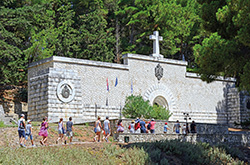 ”Heroes! I lead you into another war, against a small but brave nation. These are Serbs who, in the past three wars, against Turkey, Bulgaria and Austro-Hungary, have given to the world the evidence of high military virtues and the highest military abilities, and who have written the biggest and the most famous victories in these past four years on their blood splattered flags.”
”Heroes! I lead you into another war, against a small but brave nation. These are Serbs who, in the past three wars, against Turkey, Bulgaria and Austro-Hungary, have given to the world the evidence of high military virtues and the highest military abilities, and who have written the biggest and the most famous victories in these past four years on their blood splattered flags.”
A big campaign against a small but proud country was entrusted to the German Field-Marshal August von Mackensen, who commanded the joint Austro-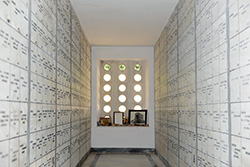 Hungarian and German forces. The attack on Belgrade began with artillery fire from the other bank of the Danube, on October 5, 1915, in the evening. The force of the artillery fire is best illustrated by the fact that more than a half Serbian artillery batteries ere neutralized by midnight, and shortly after midnight, because of the intensity of the attacks and precision of enemy cannons, all spotlights were destroyed and the capital city fell into darkness. The struggle for Belgrade that lasted days and nights, with enormous sacrifices from both sides, lasted eight days. After withdrawal of defense units, on
Hungarian and German forces. The attack on Belgrade began with artillery fire from the other bank of the Danube, on October 5, 1915, in the evening. The force of the artillery fire is best illustrated by the fact that more than a half Serbian artillery batteries ere neutralized by midnight, and shortly after midnight, because of the intensity of the attacks and precision of enemy cannons, all spotlights were destroyed and the capital city fell into darkness. The struggle for Belgrade that lasted days and nights, with enormous sacrifices from both sides, lasted eight days. After withdrawal of defense units, on 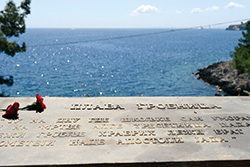 October 14, the units of Central Powers took control over Belgrade, and on that same day, from the back, without announcing a war, the First and Second Bulgarian army attacked from the south, which led to the unconditional retreat toward Montenegro and Albania. The proposal of Duke Živojin Mišić to launch a new counter-attack just like on the Kolubara was accepted and then rejected twice. At the end, on November 25, the Supreme Command makes the decisive decision about withdrawal to the Adriatic Sea.
October 14, the units of Central Powers took control over Belgrade, and on that same day, from the back, without announcing a war, the First and Second Bulgarian army attacked from the south, which led to the unconditional retreat toward Montenegro and Albania. The proposal of Duke Živojin Mišić to launch a new counter-attack just like on the Kolubara was accepted and then rejected twice. At the end, on November 25, the Supreme Command makes the decisive decision about withdrawal to the Adriatic Sea.
PEOPLE IN THE ROW OF THE FORGOTTEN
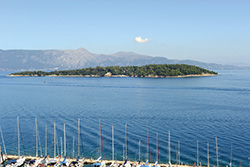 The arrival in the ”Green Island”, ”Salvation Island”, ”Island of Hope” was preceded by suffering unprecedented in the history of warfare, which is also confirmed by French Marshall Joseph Joffre: ”Withdrawal of our allies the Serbs, in circumstances in which it was carried out, by the sheer horror of it has exceeded everything the history has known until now as the most tragic.”
The arrival in the ”Green Island”, ”Salvation Island”, ”Island of Hope” was preceded by suffering unprecedented in the history of warfare, which is also confirmed by French Marshall Joseph Joffre: ”Withdrawal of our allies the Serbs, in circumstances in which it was carried out, by the sheer horror of it has exceeded everything the history has known until now as the most tragic.”
It was a drama in which the ill-intentions of nature and man competed. The harsh winter killed as much as hunger, diseases competed with ambushes of Albanian gangs who looted those who remained, exhausted and dying. The drama was intensified by hypocrisy of the allies. Frustrations of the Englishmen because of the debacle near Gallipoli reflecte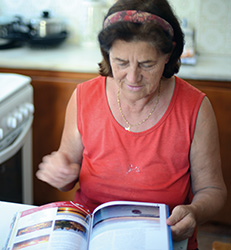 d also on the broken echelons of exhausted Serbian soldiers, scattered around from Durrës to Vlorë. The nightmare and hopelessness were intensified with expectation of the uncertain arrival of allied ships. In that moment, Serbs became only a part of the statistical balance of the war. The right side column, written-off.
d also on the broken echelons of exhausted Serbian soldiers, scattered around from Durrës to Vlorë. The nightmare and hopelessness were intensified with expectation of the uncertain arrival of allied ships. In that moment, Serbs became only a part of the statistical balance of the war. The right side column, written-off.
The cry of Serbian supreme commander, Regent Aleksandar, to Russian Emperor Nikolai Romanov, bore fruit. The holy martyr-emperor, himself shaken because of the tragedy of the Slavic brothers, gives an ultimatum to the allies:
”If the Serbian army is not rescued from Albania immediately, Russia will terminate the alignment with the Entente and make a separate peace treaty with Germany.”
The policy that was, after the liberation and the end of World War One, led by Aleksandar Karađorđević, the King-Unifier, was crowned on Serbian bones, by creating an unnatural and unsustainable unity of the opposites, may be defined as completely erroneous, but his knightly demeanor in the most decisive moments when, himself sick and after having a surgery in Skadar, he refuses to abandon his army and people, abolishing it from ”Yugoslav blindness” and the imperial dream of restoration of the medieval kingdom.
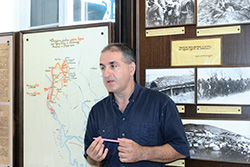 Among the bright examples in Albania, one must certainly not forget Esad-Pasha Toplani. As an ardent supporter of the idea that the Balkans belonged to the Balkan peoples, in October 1914 he took power in central Albania and Albanian proclaimed the Albanian Islamic Emirate, and next year, on the St. Vitus's Day, after the intervention of the Serbian army that prevented the attempt at overthrowing him, signed a secret agreement on the union between the Kingdom of Serbia and the Albanian Islamic Emirate. During the withdrawal, Esad-Pasha Toplani provided logistics for the Serbian army and retreat in the territories that were more or less controlled by his gendarmerie, although he had many enemies in the broken land divided into tribes, with the majority of population supporting the Ottoman Empire and the Central Powers.
Among the bright examples in Albania, one must certainly not forget Esad-Pasha Toplani. As an ardent supporter of the idea that the Balkans belonged to the Balkan peoples, in October 1914 he took power in central Albania and Albanian proclaimed the Albanian Islamic Emirate, and next year, on the St. Vitus's Day, after the intervention of the Serbian army that prevented the attempt at overthrowing him, signed a secret agreement on the union between the Kingdom of Serbia and the Albanian Islamic Emirate. During the withdrawal, Esad-Pasha Toplani provided logistics for the Serbian army and retreat in the territories that were more or less controlled by his gendarmerie, although he had many enemies in the broken land divided into tribes, with the majority of population supporting the Ottoman Empire and the Central Powers.
DRAMA OF LIFE AND DRAMA OF DEATH
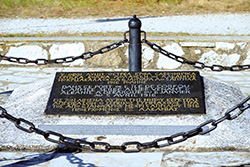 The first ship with Serbian army arrived in the Corfu harbor Gouvia, which is six kilometers away from the city of Corfu, on January 18, 1916. In one month, more precisely until February 21, with 43 allied ships, 150,000 Serbs were evacuated to Corfu. There, on the ”Salvation Island”, death took a new form. Typhoid fever and exhaustion were taking their toll mercilessly.
The first ship with Serbian army arrived in the Corfu harbor Gouvia, which is six kilometers away from the city of Corfu, on January 18, 1916. In one month, more precisely until February 21, with 43 allied ships, 150,000 Serbs were evacuated to Corfu. There, on the ”Salvation Island”, death took a new form. Typhoid fever and exhaustion were taking their toll mercilessly.
”At the beginning, as many as 150 people were dying daily on the Vidos Island. They would discard their bodies from the shore into the sea. I visited Vidos 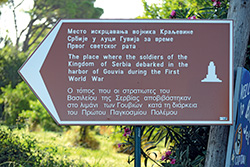 and then I saw those martyrs who had been sentenced to death of exhaustion. I couldn’t imagine that a human being could turn into such a skeleton, in the literal sense of the word, a skeleton covered by skin”, wrote Russian Prince Grigorije Nikolajevič Trubecki.
and then I saw those martyrs who had been sentenced to death of exhaustion. I couldn’t imagine that a human being could turn into such a skeleton, in the literal sense of the word, a skeleton covered by skin”, wrote Russian Prince Grigorije Nikolajevič Trubecki.
Sound of the waves, while we were approaching Vidos, the island of death and horror, carried images of dying soldiers – skeletons, dying on straw mats in a foreign country. Around 10,000 Serbs were buried on Vidos and in the blue grave, into which the dead soldiers were laid in the sea depths from the French 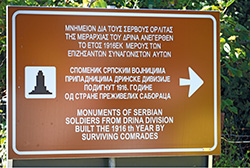 sanitary ship ”Saint Francis of Assisi”, as well as on 27 other cemeteries in Corfu Island. In the mausoleum on Vidos Island, designed by Nikolai Krasnov, and built in 1938 under the auspices of King Aleksandar Karađorđević, bones of 2,732 s
sanitary ship ”Saint Francis of Assisi”, as well as on 27 other cemeteries in Corfu Island. In the mausoleum on Vidos Island, designed by Nikolai Krasnov, and built in 1938 under the auspices of King Aleksandar Karađorđević, bones of 2,732 s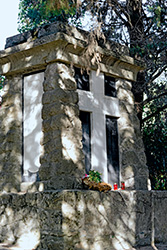 oldiers were buried, of which 1,232 were identified, while the remaining 1,500 still lie there as unknown heroes of a big epos of Serbian people.
oldiers were buried, of which 1,232 were identified, while the remaining 1,500 still lie there as unknown heroes of a big epos of Serbian people.
The drama of life on the island of snakes, as they used to call Vidos, and the drama of a nation, is best described by Vladimir Stanojević:
”There, in that Hade, collected as in the focus, the entire tragedy of our country took place in a miniature. There, in the ranting and moaning of dying people, all most gentle fibers of human soul were trembling and fluttering. There, ranting and moaning about the village and home, one after the other, all those who had been thrown into this hell by ill-fate, were disappearing...”
JERUSALEM ON THE ISLAND OF SNAKES
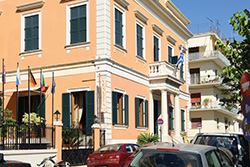 The Minister of Education of the Kingdom of Serbia, Ljuba Davidović, wrote in his journal, on January 21, 1916, and published in daily paper Pravda in the eve of World War Two:
The Minister of Education of the Kingdom of Serbia, Ljuba Davidović, wrote in his journal, on January 21, 1916, and published in daily paper Pravda in the eve of World War Two:
”In the first days, only the first days, the ill people were lying on the ground over fresh straws. We visited them every day. Fear of hunger was greater than fear of death. Hunger raged throughout Albania: it was feared in Corfu as well. Requisition for bread, for military rations, was the highest valuable. They would take them from the requisition, although they could not and should not eat it. Their digestive organs deteriorated. They were treated with water in which rice had been boiled. We were poisoned by doctors with sea water, they used to say. We assured them that the doctors and orderlies were our great friends. Both the doctors and orderlies gave most effort to save our half-dead children.
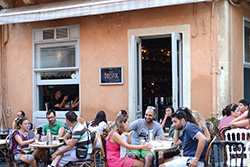 Their nerves were also deteriorated. If you say a word in Serbian to them, they would start crying. We cry together. Oh, how many tears were shed! With untouched ration under his head, he let go of his tortured soul. The child-soldier died thinking of his mother and the shabby shack in Šumadija. Faces of those dead children were true images of saints. They deserved to be proclaimed saints after everything they suffered.
Their nerves were also deteriorated. If you say a word in Serbian to them, they would start crying. We cry together. Oh, how many tears were shed! With untouched ration under his head, he let go of his tortured soul. The child-soldier died thinking of his mother and the shabby shack in Šumadija. Faces of those dead children were true images of saints. They deserved to be proclaimed saints after everything they suffered.
Only one case. He had his requisition for the ration. He took another requisition from the pocket of his dead comrade. With two requisitions he had for two more rations. He crawled to his place, to his bed, laid down and died hungry between two breads.
We could describe hundreds of thousands of other examples. Enough! Some ask: have we paid our freedom and expansion of our homeland?”
According to the official report of the minister of defense, General Božidar Terzić, over 243.000 people died prior to the arrival in Corfu.
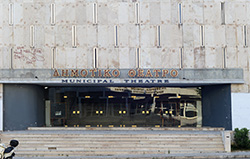 After embarking the allied ships from the harbor of Durrës, around 150,000 soldiers arrived in Corfu, while 12,000 were evacuated in Bizerte.
After embarking the allied ships from the harbor of Durrës, around 150,000 soldiers arrived in Corfu, while 12,000 were evacuated in Bizerte.
While the old boat is approaching Vidos Island, for which the metropolitan, later Patriarch Dimitrije said it was Serbian Jerusalem, the blue-eyed boy, pointing with his finger to the beautiful sandy beach, asks his father in sweet voice whether they would go for a swim here.
”For us, the Serbs, this is a holy place! It is a blue grave where brother next to brother is lying. Neither Greeks nor Serbs swim here, and Greek fishermen, out of respect for Serbian soldiers, did not fish here for 50 years”, the young men replied gently, stroking the hair of the weakly heir.
TIMES OF PAIN AND PRIDE
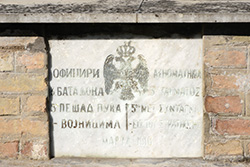 Even today, the local people still remember the stay of Serbian army and the refugees. There is almost not a place on the island that does not cherish the memory of that time. Exhausted, hungry and helpless, they were dislocated all over the island. The local population, with fear and disapprovingly welcomed the poor men ousted from their homeland, carrying in their dried eyes and withered lips memory of their homes. Skepticism and distrust in the uninvited guests disappeared like the sea foam. Vibration of the soul of brothers in religion soon bridged all the barriers of fear of unknown, and some Serbian names are still widely used among the local population.
Even today, the local people still remember the stay of Serbian army and the refugees. There is almost not a place on the island that does not cherish the memory of that time. Exhausted, hungry and helpless, they were dislocated all over the island. The local population, with fear and disapprovingly welcomed the poor men ousted from their homeland, carrying in their dried eyes and withered lips memory of their homes. Skepticism and distrust in the uninvited guests disappeared like the sea foam. Vibration of the soul of brothers in religion soon bridged all the barriers of fear of unknown, and some Serbian names are still widely used among the local population.
”Within a period of two and a half years, which is how long they stayed in Corfu, no incident has been recorded. Not a single branch was broken, not a single theft, fight, no problem was reported to the allied administration”, says Ljubomir Saramandić, curator of the Serbian House in Corfu, adding that nowhere else had the camps been so neat like in Corfu.
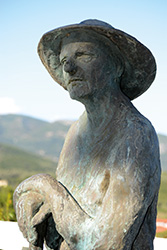 ”In open spaces in between the olive groves they erected tents decorated with flowers and greenery. With fine gravel and rocks of different shades they wrote names of units and insignia of the Serbian army and state. Camps of the Serbian army looked like fantastic castles built on a sandy sea shore”, says to the visitors this guardian of memory of Serbian Golgotha, whose grandfathers Stojan Saramandić and Dragić Milošević crossed Albania and stayed in Corfu.
”In open spaces in between the olive groves they erected tents decorated with flowers and greenery. With fine gravel and rocks of different shades they wrote names of units and insignia of the Serbian army and state. Camps of the Serbian army looked like fantastic castles built on a sandy sea shore”, says to the visitors this guardian of memory of Serbian Golgotha, whose grandfathers Stojan Saramandić and Dragić Milošević crossed Albania and stayed in Corfu.
After arriving in Corfu, all Serbian state institutions continued to work. ”Serbian state, as formulated in the order of the Supreme Command, did not lose its being, although on a foreign land, for as long as the Ruler, Government and the army are here, no matter what its strength might be.”
The building of the Corfu theatre became the seat of the Parliament, government and most state institutions.
Warm welcome grew into lasting friendships, certain attractions gave birth to love, crowned by marriage. Janis Gazis, owner of ”Bella Venetia” Hotel, where the government of the Republic of Serbia was located and where the Corfu Declaration was signed, married all of his three daughters to Serbs, the eldest Giovanna to cavalry officer Milivoje Čolak Antić, the middle one Sapro to Vladimir Kazimirović, and the youngest Augusta became the wife of Milan Stojadinović, later Prime Minister of Yugoslavia.
SERBS SING EVEN IN THE MOST DIFFICULT TIMES
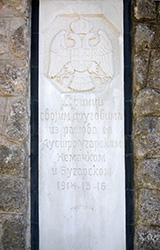 In his book Pilgrimage in Corfu, Ljubomir Saramandić, through abundance of documents and testimonies, archives the memories of those difficult and knightly times. In numerous examples of relations between the local population and the Serbs, he published a letter of a Corfu girl, addressed to a Serbian officer:
In his book Pilgrimage in Corfu, Ljubomir Saramandić, through abundance of documents and testimonies, archives the memories of those difficult and knightly times. In numerous examples of relations between the local population and the Serbs, he published a letter of a Corfu girl, addressed to a Serbian officer:
”Corfu is just as it was before 1916. It even seems to me that it is worse than before. It is silent, desolated, nobody sings any more. Your people always sing, I was so used to that murmur. You may count me as a great enemy of your people, because I always wanted you to come back to your country as late as possible. You came, you showed us what life means and you left, leaving us miserable...”
Seventy-year old Marija, owner of the apartment in Gouvia, located only about a hundred meters from the beach where the Serbian army disembarked on January 18, 1916, inherited the memory from her grandmother who, like many, used to supply Serbian soldiers with food and clothes:
My grandmother used to knit socks for them, patched clothes, brought food to the camp which was located on the beach. As long as she lived she knew the verses of the song 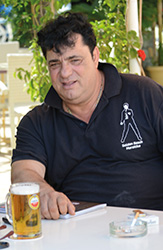 ”There, Far Away”. She said that they had been singing and crying, the elderly lady recalls, offering wine for Serbian friends.
”There, Far Away”. She said that they had been singing and crying, the elderly lady recalls, offering wine for Serbian friends.
English doctor Isabella Hutton, our curator says, noted that song was an integral part of life of every Serb:
”As soon as the Serb recovers, he sings and dances... Their favorite song is ”There, Far Away”, it talks about how they left their homes and country, about the longing for home. Some of us women used to sing together with the soldiers and through this song with many verses, we fell in love with this beautiful language.”
They also sang and cried, those ”Prometheuses of hope, apostles of sorrow”, in the yard of Yanis Yanulis in Agios Matheos, where members of the Drina Division were stationed.
Last year, for the Day of Truce, his grandson, Christo Yanulis, better known as Elvis Presley, organized lunch for about one hundred pilgrims from Serbia.
”My heart was full when I saw those people. They came to visit the monument to my grandfather Yanis. When they sat down and started singing the song that my grandfather used to sing, I told to my staff to take out everything we have in the restaurant. I remembered his words as they sat at the long wooden table, brought their rations, and he was serving wine and olives. I was happy to be able to welcome the descendants of my grandfather’s friends, and I know that he also rejoices up there in heaven”, Elvis Presley of Corfu speaks excitedly, adding that only when the Serbs erected a monument in the center of the village he became aware of the magnitude of grandfather’s actions and words that the Serbs would never forget him.
REINTRODUCE FIELD TRIPS FOR STUDENTS
Simple Greek peasant, Yanis Yanulis, true to the spirit of the Gospel and his faith shared bread and wine with Serbian brothers. And more than that! Seeing that his friends have a problem with burying their killed fellow soldiers, he gave up a part of his estate where the cemetery of the Drina Division was established. The remains of killed soldiers were transferred into the memorial charnel house on Vidos, and on the estate of Yanis Yanulis, in the shade of olive trees, those who survived built a monument to their killed fellow soldiers. In the center of Agios Matheos, the Association for Nurturing Traditions of Liberation Wars, erected a monument to the great Serbian benefactor and friend Yanis Yanulis.
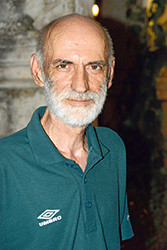 Želјko Popović, the founder of the Association of Greek-Serbian Friendship in Corfu and Serbian bookstore in Corfu, says that a large number of renowned citizens of Corfu, headed the former mayor Sotirios Mikalef who, during his mandate, donated the Serbian House and initiated fraternization between Belgrade and Corfu, has been taking actions to preserve from oblivion the memory of the stay of Serbian army.
Želјko Popović, the founder of the Association of Greek-Serbian Friendship in Corfu and Serbian bookstore in Corfu, says that a large number of renowned citizens of Corfu, headed the former mayor Sotirios Mikalef who, during his mandate, donated the Serbian House and initiated fraternization between Belgrade and Corfu, has been taking actions to preserve from oblivion the memory of the stay of Serbian army.
Želјko, together with the youngest Serb in Corfu, his six-year old son Nikola, has been introducing to us the Serbian toponyms on the island of nymph Kerkira.
”The Vardar Division was positioned in Gouvia, Morava Division in the nearby Ipsos, Timok Division in Strongyli, Šumadija in Mesonga, Drina Division in Agios Matheos, Danube Division in Vraganiotika, Shelter for Serbian civilians in Analipsi, airplane squadron in Potamos, and the Officer hospital was located in Achillion Palace. All these are places that, together with Vidos Island, should be visited by every Serb, tourist and pilgrim.”
According to Ljubomir Saramandića, many preserved buildings from this time have remained in Corfu, but there are also those, the significance of which need to be explored, primarily in organization of the Serbian state.
”If someone was making today a film about the stay of Serbs in Corfu, it would not be necessary to build special set – the entire city is an impressive witness to Serbian history, most of Serbian monuments are in good condition, but there is a concern about too few visits from students’ field trips to Corfu. The most frequently recorded impression of the visitors is: ”Everybody who feels himself a Serb or citizen of Serbia must come to a place like this once, otherwise they will carry a great hollow inside their soul.” It is especially important that young people visit Corfu, exactly at the age when they create their personal and national identity”, Ljubomir Saramandić says.
Here, in Corfu, recuperated with attention and love of the host, then erected with the Thessaloniki Front and Kaimakchalan, storming ruthlessly toward the homeland, this small nation wrote down the ancient epics of heroism and suffering with their blood, sweat and tears.
***
Royal Example
We must also not forget the attitude of old King Petar and his message to the people in retreat: ”I know that all Serbs are ready to die for their homeland. Your elected king no longer has strength to lead his army into the battle of life and death. I am only a weak old man who can do nothing, except to bless you, all of you, Serbian soldiers, citizens, women and children of Serbia. But I swear to you: if new battles are preparing shame for us, to be defeated, I will not survive that downfall, but will die together with my homeland.”
***
Opportunity
”The upcoming jubilee, a centennial of evacuation of Serbian army in Corfu, is an opportunity for more school trips to come for a pilgrimage”, says Ljubomir Saramandić. He hopes that the state, on this occasion, would renovate the Serbian House, restore the museum exhibits that is almost a quarter of a century old, organize and publish all available lists of soldiers and civilians who escaped over Albania and stayed in Corfu.
